2006 SUBARU TRIBECA steering
[x] Cancel search: steeringPage 75 of 377
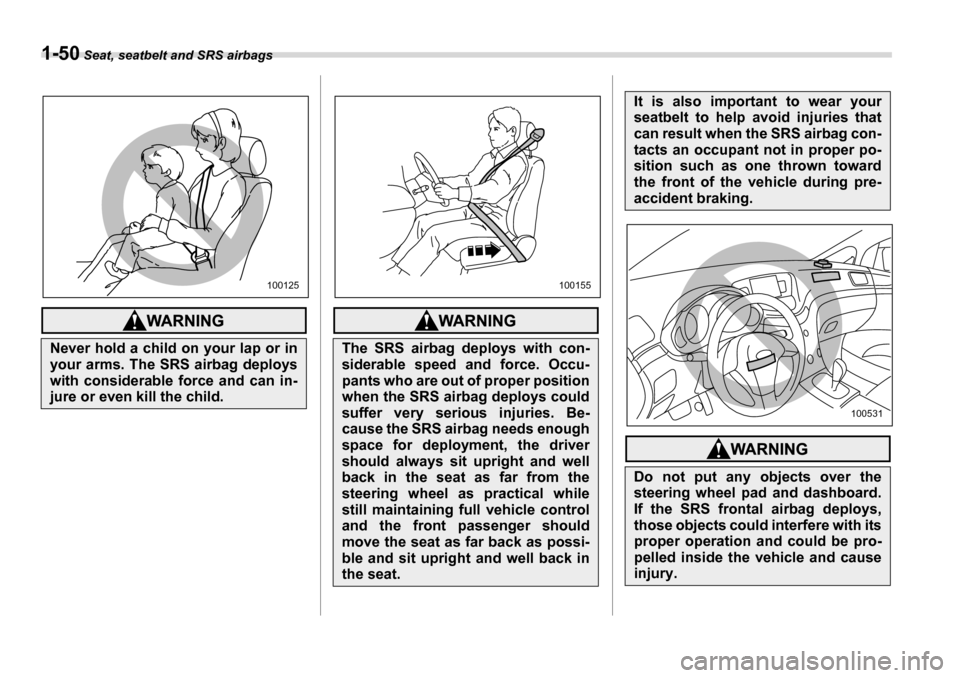
1-50 Seat, seatbelt and SRS airbags
Never hold a child on your lap or in
your arms. The SRS airbag deploys
with considerable force and can in-
jure or even kill the child.
100125
The SRS airbag deploys with con-
siderable speed and force. Occu-
pants who are out of proper position
when the SRS airbag deploys could
suffer very serious injuries. Be-
cause the SRS airbag needs enough
space for deployment, the driver
should always sit upright and well
back in the seat as far from the
steering wheel as practical while
still maintaining full vehicle control
and the front passenger should
move the seat as far back as possi-
ble and sit upright and well back in
the seat.
100155
It is also important to wear your
seatbelt to help avoid injuries that
can result when the SRS airbag con-
tacts an occupant not in proper po-
sition such as one thrown toward
the front of the vehicle during pre-
accident braking.
Do not put any objects over the
steering wheel pad and dashboard.
If the SRS frontal airbag deploys,
those objects could interfere with its
proper operation and could be pro-
pelled inside the vehicle and cause
injury.
100531
Page 80 of 377
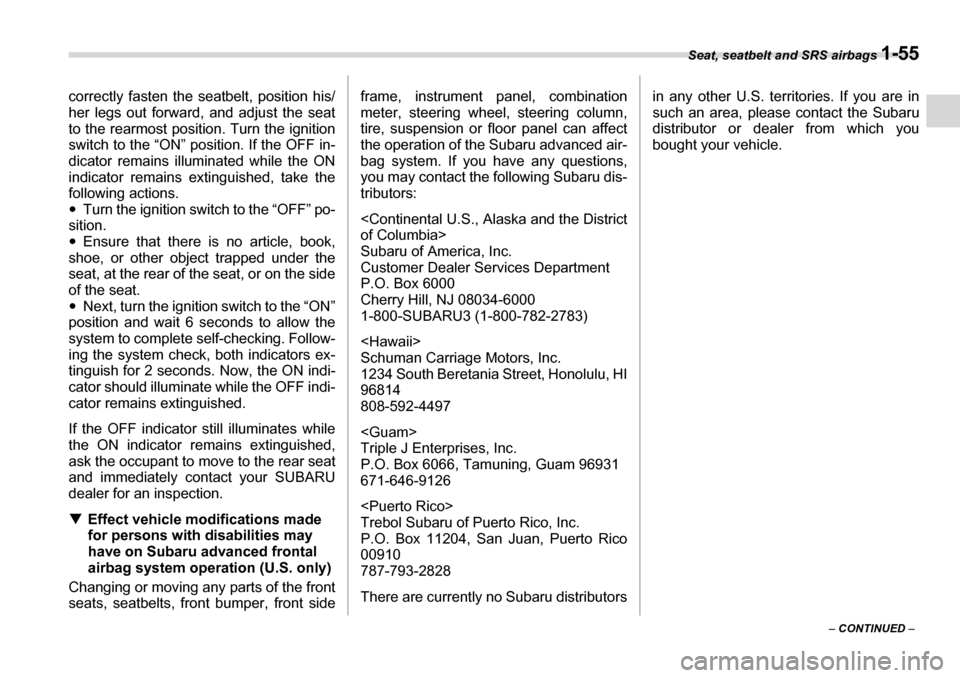
Seat, seatbelt and SRS airbags 1-55
– CONTINUED –
correctly fasten the seatbelt, position his/
her legs out forward, and adjust the seat
to the rearmost position. Turn the ignition
switch to the “ON” position. If the OFF in-
dicator remains illuminated while the ON
indicator remains extinguished, take the
following actions. �y
Turn the ignition switch to the “OFF” po-
sition. �y Ensure that there is no article, book,
shoe, or other object trapped under the
seat, at the rear of the seat, or on the side
of the seat. �y Next, turn the ignition switch to the “ON”
position and wait 6 seconds to allow the
system to complete self-checking. Follow-
ing the system check, both indicators ex-
tinguish for 2 seconds. Now, the ON indi-
cator should illuminate while the OFF indi-
cator remains extinguished.
If the OFF indicator still illuminates while
the ON indicator remains extinguished,
ask the occupant to move to the rear seat
and immediately contact your SUBARU
dealer for an inspection. �T Effect vehicle modifications made
for persons with disabilities may
have on Subaru advanced frontal
airbag system operation (U.S. only)
Changing or moving any parts of the front
seats, seatbelts, front bumper, front side frame, instrument panel, combination
meter, steering wheel, steering column,
tire, suspension or floor panel can affect
the operation of the Subaru advanced air-
bag system. If you have any questions,
you may contact the following Subaru dis-
tributors:
Subaru of America, Inc.
Customer Dealer Services Department
P.O. Box 6000
Cherry Hill, NJ 08034-6000
1-800-SUBARU3 (1-800-782-2783)
Schuman Carriage Motors, Inc.
1234 South Beretania Street, Honolulu, HI
96814
808-592-4497
Triple J Enterprises, Inc.
P.O. Box 6066, Tamuning, Guam 96931
671-646-9126
Trebol Subaru of Puerto Rico, Inc.
P.O. Box 11204, San Juan, Puerto Rico
00910
787-793-2828
There are currently no Subaru distributors
in any other U.S. territories. If you are in
such an area, please contact the Subaru
distributor or dealer from which you
bought your vehicle.
Page 82 of 377
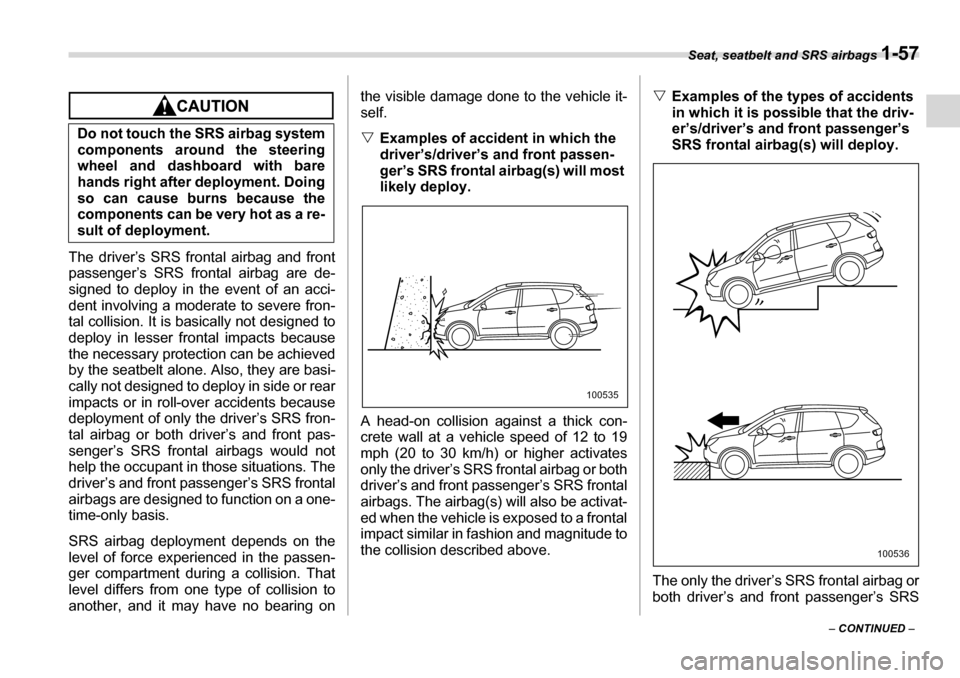
Seat, seatbelt and SRS airbags 1-57
– CONTINUED –
The driver’s SRS frontal airbag and front
passenger’s SRS frontal airbag are de-
signed to deploy in the event of an acci-
dent involving a moderate to severe fron-
tal collision. It is basically not designed to
deploy in lesser frontal impacts because
the necessary protection can be achieved
by the seatbelt alone. Also, they are basi-
cally not designed to deploy in side or rear
impacts or in roll-over accidents because
deployment of only the driver’s SRS fron-
tal airbag or both driver’s and front pas-
senger’s SRS frontal airbags would not
help the occupant in those situations. The
driver’s and front passenger’s SRS frontal
airbags are designed to function on a one-
time-only basis.
SRS airbag deployment depends on the
level of force experienced in the passen-
ger compartment during a collision. That
level differs from one type of collision to
another, and it may have no bearing on the visible damage done to the vehicle it-self. �V
Examples of accident in which the
driver’s/driver’s and front passen-
ger’s SRS frontal airbag(s) will most
likely deploy.
A head-on collision against a thick con-
crete wall at a vehicle speed of 12 to 19
mph (20 to 30 km/h) or higher activates
only the driver’s SRS frontal airbag or both
driver’s and front passenger’s SRS frontal
airbags. The airbag(s) will also be activat-
ed when the vehicle is exposed to a frontal
impact similar in fashion and magnitude to
the collision described above. �V
Examples of the types of accidents
in which it is possible that the driv-
er’s/driver’s and front passenger’s
SRS frontal airbag(s) will deploy.
The only the driver’s SRS frontal airbag or
both driver’s and front passenger’s SRS
Do not touch the SRS airbag system
components around the steering
wheel and dashboard with bare
hands right after deployment. Doing
so can cause burns because the
components can be very hot as a re-
sult of deployment.
100535
100536
Page 88 of 377
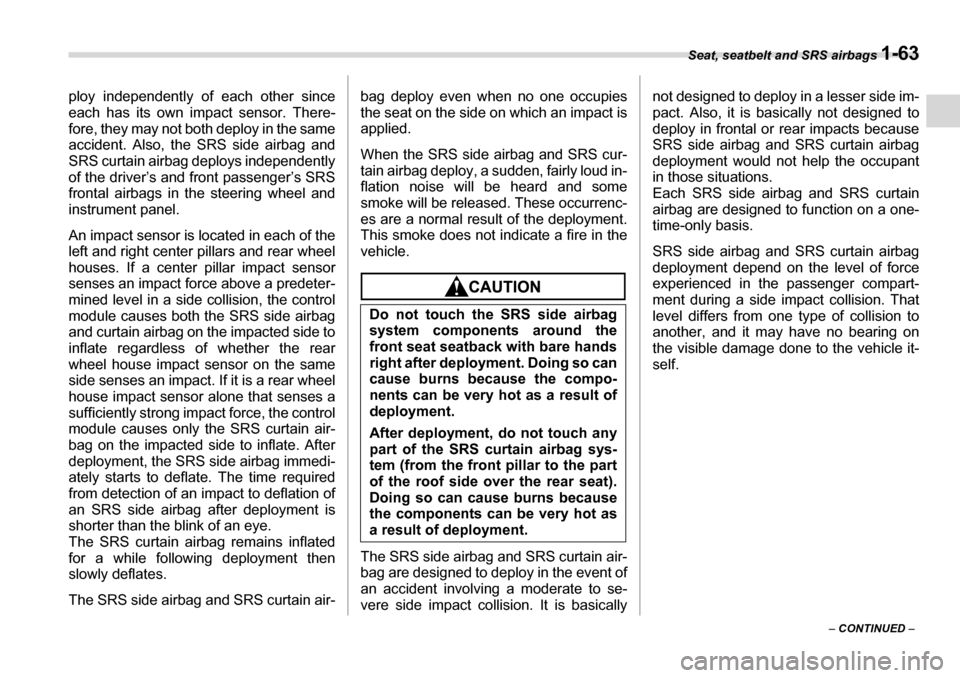
Seat, seatbelt and SRS airbags 1-63
– CONTINUED –
ploy independently of each other since
each has its own impact sensor. There-
fore, they may not both deploy in the same
accident. Also, the SRS side airbag and
SRS curtain airbag deploys independently
of the driver’s and front passenger’s SRS
frontal airbags in the steering wheel and
instrument panel.
An impact sensor is located in each of the
left and right center pillars and rear wheel
houses. If a center pillar impact sensor
senses an impact force above a predeter-
mined level in a side collision, the control
module causes both the SRS side airbag
and curtain airbag on the impacted side to
inflate regardless of whether the rear
wheel house impact sensor on the same
side senses an impact. If it is a rear wheel
house impact sensor alone that senses a
sufficiently strong impact force, the control
module causes only the SRS curtain air-
bag on the impacted side to inflate. After
deployment, the SRS side airbag immedi-
ately starts to deflate. The time required
from detection of an impact to deflation of
an SRS side airbag after deployment is
shorter than the blink of an eye.
The SRS curtain airbag remains inflated
for a while following deployment then
slowly deflates.
The SRS side airbag and SRS curtain air-
bag deploy even when no one occupies
the seat on the side on which an impact is
applied.
When the SRS side airbag and SRS cur-
tain airbag deploy, a sudden, fairly loud in-
flation noise will be heard and some
smoke will be released. These occurrenc-
es are a normal result of the deployment.
This smoke does not indicate a fire in thevehicle.
The SRS side airbag and SRS curtain air-
bag are designed to deploy in the event of
an accident involving a moderate to se-
vere side impact collision. It is basically not designed to deploy in a lesser side im- pact. Also, it is basically not designed to
deploy in frontal or rear impacts because
SRS side airbag and SRS curtain airbag
deployment would not help the occupant
in those situations.Each SRS side airbag and SRS curtain
airbag are designed to function on a one- time-only basis.
SRS side airbag and SRS curtain airbag
deployment depend on the level of force
experienced in the passenger compart-
ment during a side impact collision. That
level differs from one type of collision to
another, and it may have no bearing on
the visible damage done to the vehicle it-self.
Do not touch the SRS side airbag
system components around the
front seat seatback with bare hands
right after deployment. Doing so can
cause burns because the compo-
nents can be very hot as a result of
deployment.
After deployment, do not touch any
part of the SRS curtain airbag sys-
tem (from the front pillar to the part
of the roof side over the rear seat).
Doing so can cause burns because
the components can be very hot as
a result of deployment.
Page 93 of 377
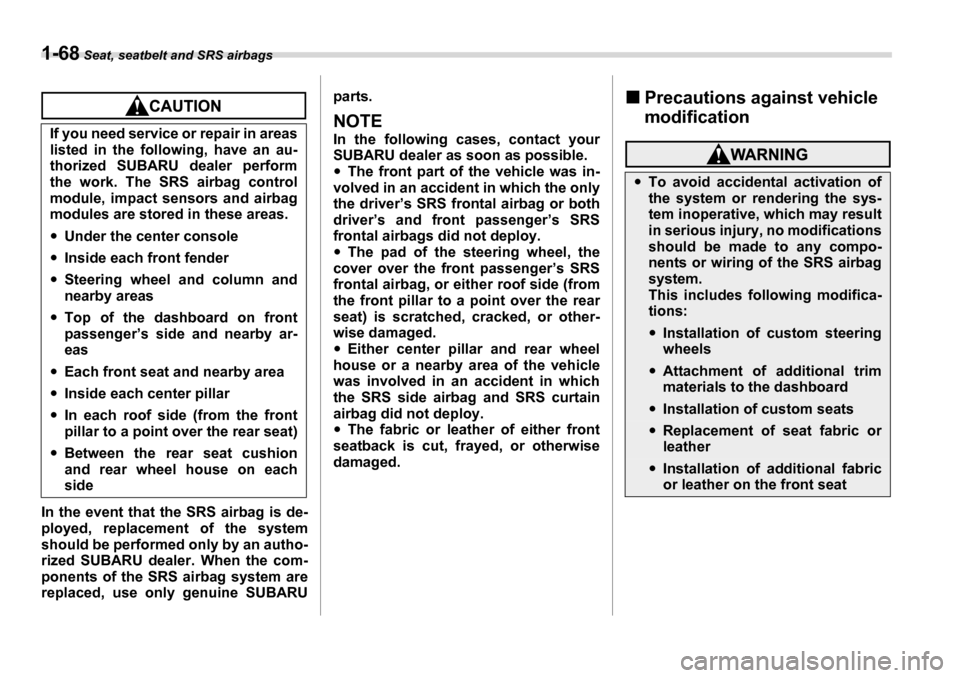
1-68 Seat, seatbelt and SRS airbags
In the event that the SRS airbag is de-
ployed, replacement of the system
should be performed only by an autho-
rized SUBARU dealer. When the com-
ponents of the SRS airbag system are
replaced, use only genuine SUBARU parts.
NOTE
In the following cases, contact your
SUBARU dealer as soon as possible. �y
The front part of the vehicle was in-
volved in an accident in which the only
the driver’s SRS frontal airbag or both
driver’s and front passenger’s SRS
frontal airbags did not deploy.�y The pad of the steering wheel, the
cover over the front passenger’s SRS
frontal airbag, or either roof side (from
the front pillar to a point over the rear
seat) is scratched, cracked, or other-
wise damaged.�y Either center pillar and rear wheel
house or a nearby area of the vehicle
was involved in an accident in which
the SRS side airbag and SRS curtain
airbag did not deploy. �y The fabric or leather of either front
seatback is cut, frayed, or otherwise
damaged. �„
Precautions against vehicle
modificationIf you need service or repair in areas
listed in the following, have an au-
thorized SUBARU dealer perform
the work. The SRS airbag control
module, impact sensors and airbag
modules are stored in these areas. �yUnder the center console
�y Inside each front fender
�y Steering wheel and column and
nearby areas
�y Top of the dashboard on front
passenger’s side and nearby ar- eas
�y Each front seat and nearby area
�y Inside each center pillar
�y In each roof side (from the front
pillar to a point over the rear seat)
�y Between the rear seat cushion
and rear wheel house on each
side
�yTo avoid accidental activation of
the system or rendering the sys-
tem inoperative, which may result
in serious injury, no modifications
should be made to any compo-
nents or wiring of the SRS airbag
system.
This includes following modifica- tions:
�yInstallation of custom steering
wheels
�yAttachment of additional trim
materials to the dashboard
�yInstallation of custom seats
�yReplacement of seat fabric or
leather
�yInstallation of additional fabric
or leather on the front seat
Page 123 of 377
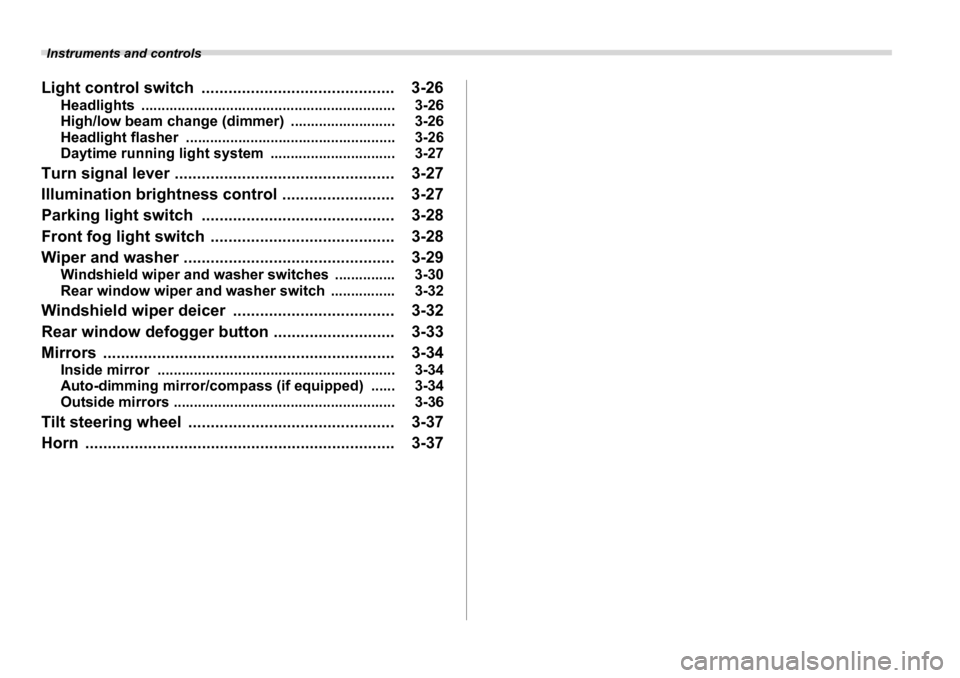
Instruments and controls
Light control switch ........................................... 3-26
Headlights ............................................................... 3-26
High/low beam change (dimmer) .......................... 3-26
Headlight flasher .................................................... 3-26
Daytime running light system ............................... 3-27
Turn signal lever ................................................. 3-27
Illumination brightness control ......................... 3-27
Parking light switch ........................................... 3-28
Front fog light switch ......................................... 3-28
Wiper and washer ............................................... 3-29 Windshield wiper and washer switches ............... 3-30
Rear window wiper and washer switch ................ 3-32
Windshield wiper deicer .................................... 3-32
Rear window defogger button ........................... 3-33
Mirrors ................................................................. 3-34 Inside mirror ........................................................... 3-34
Auto-dimming mirror/compass (if equipped) ...... 3-34
Outside mirrors ....................................................... 3-36
Tilt steering wheel .............................................. 3-37
Horn ..................................................................... 3-37
Page 124 of 377
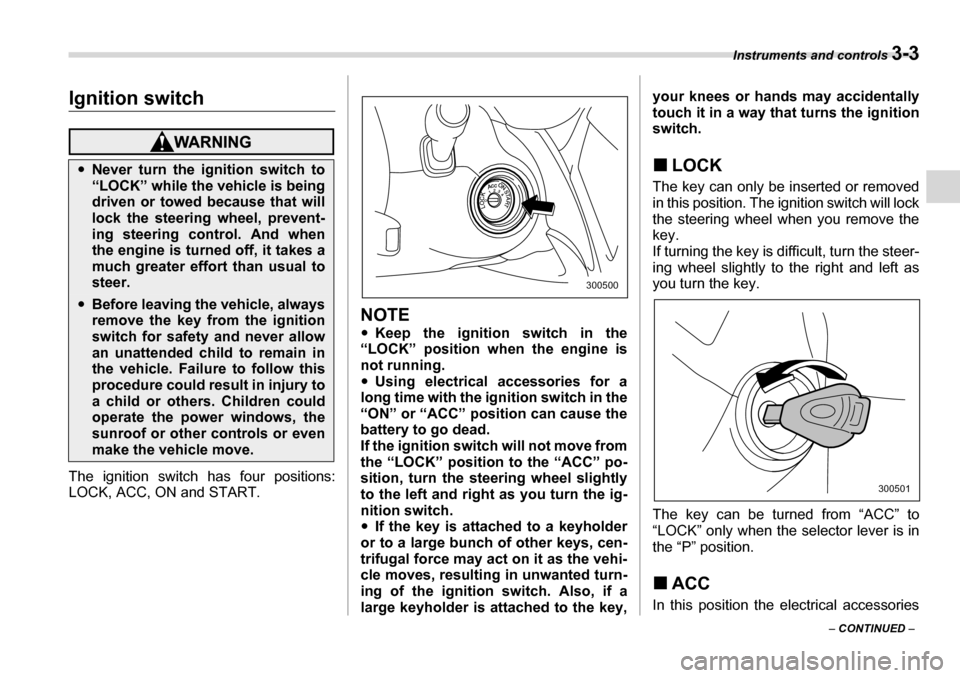
Instruments and controls 3-3
– CONTINUED –
Instruments and controlsIgnition switch
The ignition switch has four positions:
LOCK, ACC, ON and START.
NOTE �yKeep the ignition switch in the
“LOCK” position when the engine is
not running. �y Using electrical accessories for a
long time with the ignition switch in the
“ON” or “ACC” position can cause the
battery to go dead.
If the ignition switch will not move from
the “LOCK” position to the “ACC” po-
sition, turn the steering wheel slightlyto the left and right as you turn the ig-
nition switch. �y If the key is attached to a keyholder
or to a large bunch of other keys, cen-
trifugal force may act on it as the vehi-
cle moves, resulting in unwanted turn-
ing of the ignition switch. Also, if a
large keyholder is attached to the key, your knees or hands may accidentally
touch it in a way that turns the ignition
switch. �„
LOCK
The key can only be inserted or removed
in this position. The ignition switch will lock
the steering wheel when you remove the key.
If turning the key is difficult, turn the steer-
ing wheel slightly to the right and left as
you turn the key.
The key can be turned from “ACC” to
“LOCK” only when the selector lever is in
the “P” position. �„ ACC
In this position the electrical accessories
�y Never turn the ignition switch to
“LOCK” while the vehicle is being
driven or towed because that will
lock the steering wheel, prevent-
ing steering control. And when
the engine is turned off, it takes a
much greater effort than usual to
steer.
�yBefore leaving the vehicle, always
remove the key from the ignition
switch for safety and never allow
an unattended child to remain in
the vehicle. Failure to follow this
procedure could result in injury to
a child or others. Children could
operate the power windows, the
sunroof or other controls or even
make the vehicle move.
300500
300501
Page 158 of 377
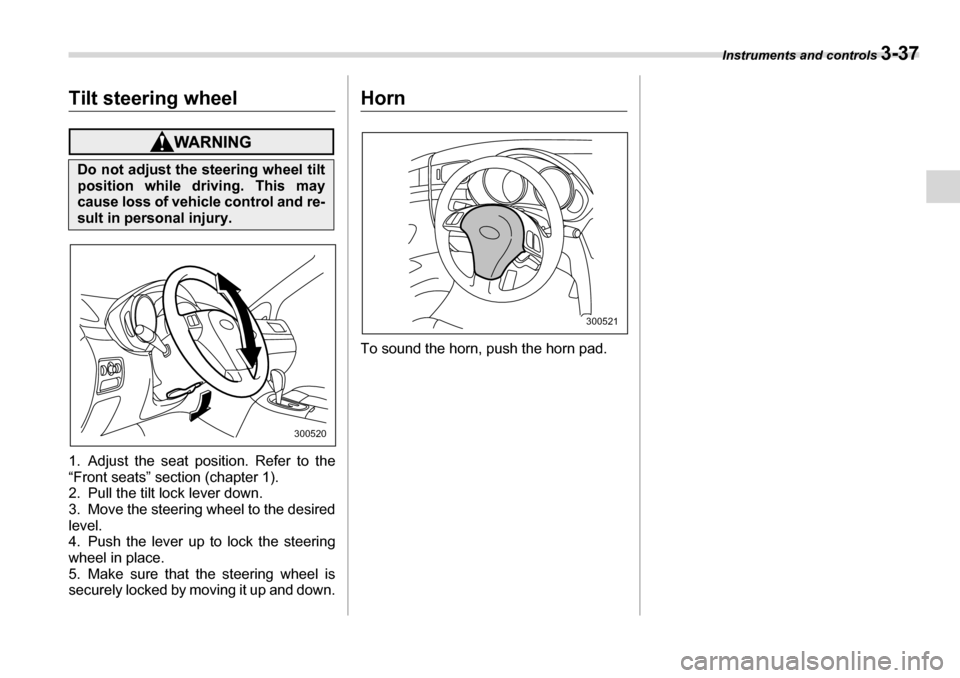
Instruments and controls 3-37
Tilt steering wheel
1. Adjust the seat position. Refer to the
“Front seats” section (chapter 1).
2. Pull the tilt lock lever down.
3. Move the steering wheel to the desired
level.
4. Push the lever up to lock the steering
wheel in place.
5. Make sure that the steering wheel is
securely locked by moving it up and down.
Horn
To sound the horn, push the horn pad.
Do not adjust the steering wheel tilt
position while driving. This may
cause loss of vehicle control and re-
sult in personal injury.
300520
300521